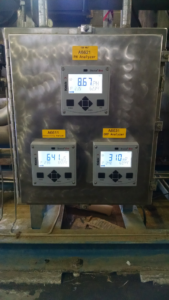Better Chemical Dosing Control Extends Filtration Membrane Life

Reverse Osmosis (RO) is a purification process which removes Total Dissolved Solids (TDS) in water by applying pressure to feedwater, forcing it through a semi-permeable membrane and allowing pure water to diffuse.
Reverse Osmosis (RO) is a purification process which removes Total Dissolved Solids (TDS) in water by applying pressure to feedwater, forcing it through a semi-permeable membrane and allowing pure water to diffuse.Conductivity is an important measurement for reverse osmosis. Consequently, having the ability to measure very low conductivity accurately is critical. Using a conductivity electrode is a common way to test RO water quality and membrane performance. Ultrapure water is a poor electrical conductor. The concentration of ionized partials, such as salts or acids, dissolved in water is what gives it its conductivity.
The Solution
Conductivity monitoring with the SE 604 Conductivity Sensor helps to ensure the optimal range of 10…20uS/cm is held. Coupling the sensor with the Stratos transmitter is a cost-effective solution. Having the ability to monitor these very low conductivity ranges allows the operator to monitor if the semi-permeable membrane is still effective.
ORP (Oxidation Reduction Potential or sometimes called redox) monitors the condition of the RO membrane. It indicates if membranes are susceptible to attack by oxidizers such as chlorine, which causes damage, shortens their useful lifespan, increasing the cost. ORP can be used to detect the addition of sodium bisulfite, which is used to reduce chlorine. Reduction of too much chlorine can cause biological growth in the system.
The SE 565 is an ideal ORP electrode. It utilizes a Silamid® reference system that resists poisoning giving the sensor longer life. As a result, this construction gives the sensor a longer life. Accurately monitoring ORP gives the operator better control of the sodium bisulfite addition reduces chemical costs and prevents overdosing of the system.
pH predicts membrane life and the scaling potential of process water. Very high or low pH indicates that scaling is forming on the membranes. Knowing the pH allows personnel to adjust the process to keep the pH in an optimal range so the membranes are free from buildup.
The SE 558 pH electrode is designed for use in low-ionic activity applications down to 10μS/cm; ideal for most RO systems. This sensor allows for accurate detection of scaling from calcium in the RO system.
What was this Customer’s Return on Investment?
- Reduced Membrane Replacements:
The customer was able to maximize membrane life due to better pH/ORP, and conductivity monitoring reducing cost from premature replacement. - Higher Process Efficiency:
The customer was able to improve process control by having accurate conductivity, ORP, and pH monitoring. This led to reduced chemical usage. - Reduced Maintenance Costs:
Technicians can calibration M4 Knick Memosens smart digital sensors in the shop, and then take them to the field. When plugged into the Stratos transmitter, the sensor automatically shares its calibration data, thus eliminating the need for calibrations in the field.


